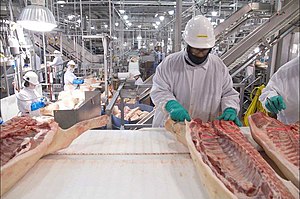The industry has an over-capacity issue which will only worsen in the next two or three years.
Steve Kay - Cattle Buyers’ Weekly
In February, I wrote that ten entities or individuals had announced plans to build new beef processing plants in the US. I am re-visiting the topic, because the outlook for these new meat ventures has deteriorated significantly in the past seven months.
I hope those people behind the proposed US plants are looking at the current and future size of the US beef herd, and how much processing capacity the industry already has.
Should they do so with an open mind, they might decide to shelve their plans and save their investors a lot of money – for the industry has an over-capacity issue which will only worsen in the next two or three years.
Declining US beef herd
The decline in the US beef herd that began in 2019 shows no sign of abating. Beef cow numbers will continue to shrink this year and there is as yet no sign of heifer retention.
Cattle numbers are unlikely to start increasing until late next year at the earliest. When that begins, the number of cattle in feedlots and going to fed beef processors will get even tighter for a year or more until they expand again.
This likely scenario has US beef processors increasingly concerned about their ability to make money for the next two years and the impact on beef demand if they force prices higher.
Tyson Foods’ beef business eked out a small profit in the calendar second quarter. JBS Beef North America had a similarly small profit in the same quarter. JBS management in fact told analysts that the outlook for beef in the US is “not going to improve soon” and this is likely to leave beef processors with unused capacity.
There is no doubt that US cattle supplies will remain tight in 2024 and no doubt that processing companies will operate using less capacity, said JBS global president of operations Wesley Batista Filho. Profit margins at JBS’s North American beef operation will remain at “low single-digit” levels, with ranchers expected to withhold females as part of efforts to replenish the herd, he told analysts.
Previous drought impact
The catastrophic drought in the US from 2010 through 2012 led to the closure of nine US beef processing plants. Industry-wide capacity by 2016 declined to 125,500 head per day from 139,000 head per day in 2010, according to my annual Cattle Buyers’ Weekly survey data.
But the capacity total has now increased considerably from that low. I calculate that the largest 71 beef processing plants in the US currently have capacity to process 134,705 head per day.
Even using a more conservative estimate of maximum daily capacity of 128,000 head, it is clear the industry is saddled with excess capacity. The 128,000 head total would mean a maximum slaughter total of 640,000 head over five days or 704,000 head over 5.5 days.
Weekly slaughter totals so far this year have been far below the 704,000 total. Year-to-date, total US cattle slaughter is down 4.1pc or 940,000 head on the same period last year. That is the equivalent of the annual slaughter total of a plant with a processing capacity of more than 3000 head per day.
The second week of January saw the largest total of the year, 660,740 head. In contrast, the first three weeks of August saw totals average only 609,000 head. That is 95pc of the five-day capacity or 87pc of the 5.5 day capacity. Such numbers make it clear why Saturday slaughter levels are often below 10,000 head.
The current over-capacity in US beef processing and little likelihood of any meaningful increase in beef cattle numbers for two years cast a shadow over the ten proposed new US beef plants.
The first was proposed three years ago and is now operating in Idaho. The ten plants have an avowed capacity of 18,190 head per day. This includes a plan to build an 8000 per day mega-plant in South Dakota. It seems likely that this plant will not get to the ground-breaking stage. The wider question is how many others will meet the same fate.
US economy continues to grow
Meanwhile, America’s remarkably strong economy continues to grow, defying the skeptics who said it would not. The trend contrasts sharply with most other beef-eating parts of the world.
The US beef industry has benefited from this growth, as beef demand at retail and in restaurants remains far better than expected.
Many in the industry had feared that record high retail beef prices from May onward would impact sales by forcing consumers to move to lower-priced cuts or to buying more pork and chicken.
That has not occurred to any large extent, even though pork’s average retail price in July was only 60pc of USDA’s All Fresh beef price.
The average chicken price was only 32pc of the beef price. I guess that proves the old adage that beef is the “meat treat” and chicken is the “survival food.”












